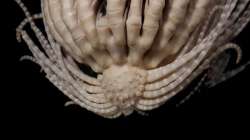'Promachocrinus fragarius': Marine scientists discover ‘strawberry feather star' with 20 arms in Antarctic
The discovery, the result of an extensive research campaign spanning nearly 10 years, has unlocked insights into the unique and fascinating systems that thrive under the Southern Ocean ice.

In a latest achievement for the scientists, researchers on board an exploration vessel close to Antarctica have uncovered an obscure marine animal, denoting an exceptional expansion of the world's biodiversity. The recently discovered species, named Promachocrinus fragarius, or the Antarctic strawberry feather star, flaunts a distinctive body structure that separates it from other marine life in the region. The discovery, the result of an extensive research campaign spanning nearly 10 years, has unlocked insights into the unique and fascinating systems that thrive under the Southern Ocean ice.
Researchers left on a few examination campaigns somewhere in the range of 2008 and 2017, exploring the Southern Sea looking for tricky and obscure ocean animals known as Promachocrinus, or Antarctic feather stars. These puzzling creatures, which show an extraordinary appearance while swimming, live at different profundities, from roughly 65 feet to around 6,500 feet submerged. Dissimilar to their all-time more notable partners, ocean stars, feather stars have a particular charm and appeal that dazzles marine scientists.
Among the examples accumulated during the studies, the specialists made an earth-shattering revelation: a formerly obscure animal type with a remarkable body setup. Named the Antarctic Strawberry Feather Star because of its uncanny similarity to a strawberry's shape, this intriguing animal flaunts a central "strawberry-like" body with a striking component: 20 arms expanding outwards. The Antarctic strawberry feather star shows a dazzling scope of varieties, from purplish shades to profound rosy tones.
Dazzling pictures of the newly discovered species uncover interesting insights concerning its life systems. The animal has two sorts of limbs, with the lower, more limited arms displaying a striped and rough surface, while the upper, longer arms seem padded and delicate. The lower body of the Antarctic strawberry feather star presents a three-sided shape, more extensive at the top and tightening towards an adjusted base tip. The surface has a finished, uneven appearance enhanced with circle-like indents, potentially remnants of severed arms.
The identification and classification of the Antarctic strawberry feather star as new species depended on a mix of its unmistakable body construction and complete DNA investigation. This calculated methodology guaranteed the exactness and validity of the discovery, setting its spot in the records of marine life science.
Also read | ISRO successfully conducts parachute deployment tests for Gaganyaan mission
Also read | Chandrayaan-3 Mission: ISRO shares pictures of Earth and Moon. Check pics